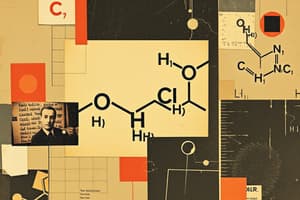Podcast
Questions and Answers
What is the energy of the resonance hybrid compared to the energy of contributing structures?
What is the energy of the resonance hybrid compared to the energy of contributing structures?
- Equal energy
- Higher energy
- Lower energy (correct)
- Not defined
Resonance structures can involve the movement of atoms.
Resonance structures can involve the movement of atoms.
False (B)
What must all resonance structures be to be valid?
What must all resonance structures be to be valid?
Proper Lewis structures
The more stable a structure is, the greater is its contribution to the _____ .
The more stable a structure is, the greater is its contribution to the _____ .
What principle states that orbitals are filled starting from the lowest energy?
What principle states that orbitals are filled starting from the lowest energy?
Which bond is characterized by circular symmetry when viewed along the bond axis?
Which bond is characterized by circular symmetry when viewed along the bond axis?
Electrons in 1s orbitals have higher energy than those in 2s orbitals.
Electrons in 1s orbitals have higher energy than those in 2s orbitals.
What is the molecular geometry of water?
What is the molecular geometry of water?
Match the hybridization with its molecular geometry:
Match the hybridization with its molecular geometry:
What is the origin of the element carbon?
What is the origin of the element carbon?
What did Friedrich Wöhler discover in 1828?
What did Friedrich Wöhler discover in 1828?
According to vitalism, organic compounds can only come from living organisms.
According to vitalism, organic compounds can only come from living organisms.
What are isotopes?
What are isotopes?
What determines the atomic number of an element?
What determines the atomic number of an element?
How many protons and neutrons are in the stable isotope 14N?
How many protons and neutrons are in the stable isotope 14N?
What is the significance of the valence electrons?
What is the significance of the valence electrons?
What is the octet rule?
What is the octet rule?
What causes the formation of an ionic bond?
What causes the formation of an ionic bond?
Electronegativity decreases as we move from left to right on the periodic table.
Electronegativity decreases as we move from left to right on the periodic table.
Which of the following compounds is purely covalent?
Which of the following compounds is purely covalent?
How do you determine the formal charge of an atom?
How do you determine the formal charge of an atom?
What are constitutional isomers?
What are constitutional isomers?
What is a resonance structure?
What is a resonance structure?
In bond-line formulas, what does a dashed wedge represent?
In bond-line formulas, what does a dashed wedge represent?
Flashcards are hidden until you start studying
Study Notes
Resonance
- The more covalent bonds a structure has, the more stable it is
- Charge separation decreases stability
Atomic Orbitals and Electron Configuration
- Electrons in 1s orbitals have the lowest energy because they are closest to the positive nucleus
- Electrons in 2s orbitals have a higher energy level than 1s orbitals
- The three 2p orbitals have equal but higher energy than the 2s orbitals
- Orbitals of equal energy are called degenerate orbitals
- The Aufbau principle states that orbitals are filled so that those of lowest energy are filled first
- The Pauli exclusion principle states that a maximum of two electrons may be placed in each orbital but only when the spins of the electrons are paired
- Hund’s rule states that when we come to orbitals of equal energy (degenerate orbitals) such as the three p orbitals, we add one electron to each with their spins unpaired until each of the degenerate orbitals contains one electron. Then we begin adding a second electron to each degenerate orbital so that the spins are paired.
Hybridization
- sp3 hybridization occurs when one s and three p orbitals hybridize resulting in four sp3 orbitals
- In an sp3 hybridized carbon the four sp3 orbitals are arranged in a tetrahedral arrangement
- sp2 hybridization occurs when one s and two p orbitals hybridize resulting in three sp2 orbitals
- In an sp2 hybridized carbon the three sp2 orbitals are arranged in a trigonal planar arrangement
- sp hybridization occurs when one s and one p orbital hybridize resulting in two sp orbitals
- In an sp hybridized carbon the two sp orbitals are arranged in a linear arrangement
Molecular Geometry: VSEPR Theory
- The Valence shell electron pair repulsion (VSEPR) model is used to predict the molecular geometry of molecules
- All valence electrons of a central atom (shared and unshared) are considered in the VSEPR model
- Electron pairs tend to stay as far apart as possible, repulsive force between nonbonding pairs is greater than that between bonding pairs
- The geometry of a molecule can be described by considering the positions of its atoms and not by the positions of the electron pairs
Studying That Suits You
Use AI to generate personalized quizzes and flashcards to suit your learning preferences.




